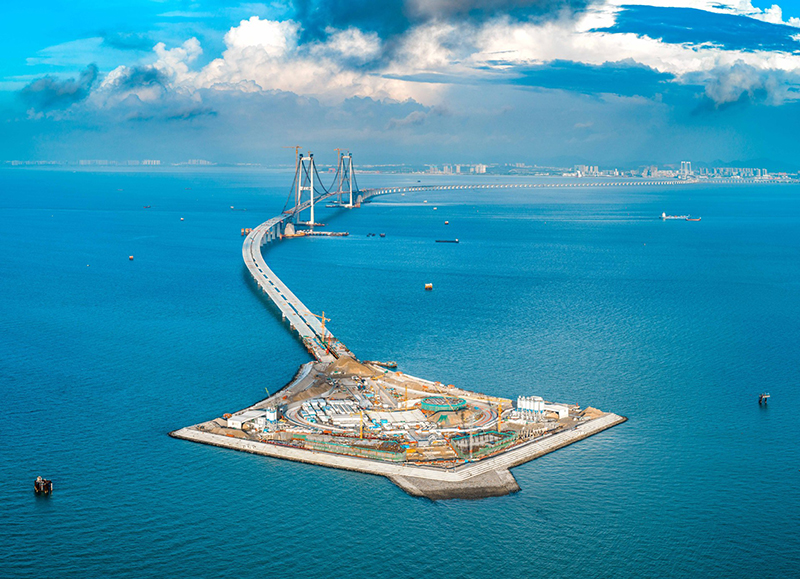
Shenzhen–Zhongshan Bridge – 24 km sea-crossing, connecting Shenzhen, Hong Kong, and Zhongshan.
The Shenzhen-Zhongshan Link is another large-scale transportation project in the Guangdong-Hong Kong-Macao Greater Bay Area (GBA), following the Hong Kong-Zhuhai-Macao Bridge, which is situated approximately 31 km south of the new link. The bridge is an important part of China’s national highway network across the Pearl River Estuary and a core transport hub project in the Guangdong-Hong Kong-Macao Greater Bay Area. It connects Shenzhen, Zhongshan, and Nansha District of Guangzhou.
This is not just a bridge project, it is a combination of several structures, such as a sea-crossing bridge, a 6.84 km long submarine tunnel, artificial islands and an underground interchange. The whole crossing is 24 km long, with a bridge section of 17 kilometers. It also boasts the only direct expressway connecting Shenzhen, Dongguan and Huizhou with Zhuhai, Zhongshan and Jiangmen.
Bridge Dimensions
The bridge’s main tower is 270-metre-high with a clearance of 76.5 metres. A 580 m cable-stayed bridge is also part of the span. This acts as a link and connection between two man-made islands and runs into a seabed along a 5km-long steel tube structure.
The bridges have a standard deck width of 40.5 m. The design service life of the project is 120 years. The construction of the project started in May 2017 and ended in June 2024.
Benefits
The Macao Greater Bay area has a population of 80 million with a traffic-heavy reputation. The bridge project helps alleviate the congestion, by reducing travel time between the city of Zhongshan and the technology hub of Shenzhen on the opposite sides of the Pearl River Estuary. The Pearl River estuary, where the Pearl River flows into the South China Sea, is one of the most densely populated areas in the world. It encompasses Hong Kong, Macao and nine cities in Guangdong, which are separated by wide bodies of water – and that makes getting around a massive pain.
The eight-lane mega transport route has a design speed of 100 km/h (62 mph). A trip that normally takes 2hrs, now only lasts 30 minutes. This will boost tourism to the area.
China aims to develop the area into a world-class cluster of cities, a global technology hub, innovation center, and a livable business-friendly location. It is a no-brainer to further develop the area by constructing this mega project. The area already has an established major network of motorways, railways, four rivers and sea bridges, five international airports and three commercial ports, which are among the largest in the world.
Construction of bridge and Challenges
More than 15,000 workers and 7 years of construction work were required to create this new direct link between the two sides of the Pearl River delta.
There are a few challenges engineers had to contend with to realize the dream of building a crossing that would allow 100,000 vehicles a day to safely cross. China’s has upped its sustainability standards in recent years, so the bar for this project was set higher than previous ones. These regulations intend to minimize the effects of construction projects on the environment. The bridge had to be built with a longer span than the world famous HZMB to meet traffic and navigation demands of the bay area. It meant that more challenges associated with design and construction of the immersed tunnel and main bridge
Arguably one of the most difficult sea-crossing construction projects in the world, the S-Z bridge crossing, had to not only adhere height clearance limitations set by to the height of the towers in the east end which had to meet the clearance limitations set by Shenzhen Airport- the east side towers had to allow flights to pass through. Engineers had to contend with flood and tide control issues. The four eastern entries to the sea of the Pearl River estuary did affect how the piers of the bridge were designed so not impede the flow of water.
Because the protected China White Dolphins use the areas as key migration route, engineers and designers had to design with this environmental issue in mind.
Due to the poor geology under which the foundation of the tunnels ran, this was a challenge. Mainly due to softening weathered rock, both soft and hard strata, liquefied sand, large back- silting of the foundation trench, and seabed evolution. Methods such as deep cement mixing and rock and aggregate levelling had to be employed to strengthen the foundation of the tunnel. Sand compact pilling was used for improved stability.
The bridge uses the latest innovation to maintain safety, including new firefighting and smoke exhaust systems. Robots are used to patrol the tunnel, monitor pipes, cables that keep everything running smoothly, and can even keep an eye out for car accidents.
- Subscribe to Our Newsletter: Stay updated with the latest insights, tips, and innovations in civil engineering.
- Check Out These Must-Read Resources:
- A comprehensive book on civil engineering to enhance your understanding of structural design and construction techniques.
- A captivating book about the lives of great civil engineers, showcasing the pioneers who shaped the modern world.
- A practical project inspection checklist—an essential tool for every engineer involved in site supervision and quality control.
- Dive into the genius of the Renaissance with our recommended book about Leonardo da Vinci, exploring his contributions to engineering and architecture.
- Don’t miss our field notebook and journal, designed specifically for civil engineers and architects to document projects, ideas, and on-site observations
No responses yet